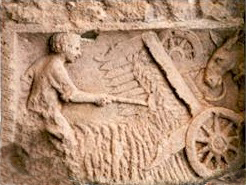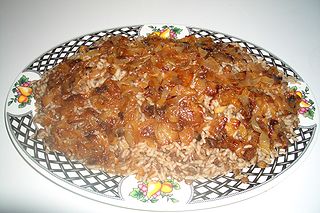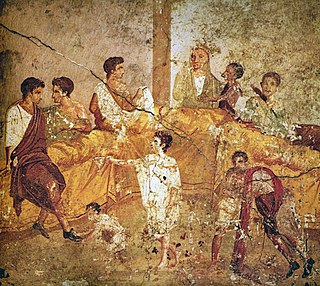Related Research Articles

Frumenty was a popular dish in Western European medieval cuisine. It is a porridge, a thick boiled grain dish—hence its name, which derives from the Latin word frumentum, "grain". It was usually made with cracked wheat boiled with either milk or broth and was a peasant staple. More luxurious recipes include eggs, almonds, currants, sugar, saffron and orange flower water. Frumenty was served with meat as a pottage, traditionally with venison or even porpoise. It was also frequently used as a subtlety, a dish between courses at a banquet.

Porridge is a food made by heating or boiling ground, crushed or chopped starchy plants, typically grain, in milk or water. It is often cooked or served with added flavourings such as sugar, honey, fruit, or syrup to make a sweet cereal, or it can be mixed with spices, meat, or vegetables to make a savoury dish. It is usually served hot in a bowl, depending on its consistency. Oat porridge, or oatmeal, is one of the most common types of porridge. Gruel is a thinner version of porridge and congee is a savoury variation of porridge of Asian origin.

The cuisine of ancient Rome changed greatly over the duration of the civilization's existence. Dietary habits were affected by the political changes from kingdom to republic to empire, and Roman trading with foreigners along with the empire's enormous expansion exposed Romans to many new foods, provincial culinary habits and cooking methods.

Carbonara is a pasta dish made with eggs, hard cheese, fatty cured pork, and black pepper. The dish took its modern form and name in the middle of the 20th century.

Polenta is a dish of boiled cornmeal that was historically made from other grains. The dish comes from Italy. It may be allowed to cool and solidify into a loaf that can be baked, fried, or grilled.
Gruel is a food consisting of some type of cereal—such as ground oats, wheat, rye, or rice—heated or boiled in water or milk. It is a thinner version of porridge that may be more often drunk rather than eaten. Historically, gruel has been a staple of the Western diet, especially for peasants. Gruel may also be made from millet, hemp, barley, or, in hard times, from chestnut flour or even the less bitter acorns of some oaks. Gruel has historically been associated with feeding the sick and recently-weaned children.

Roman agriculture describes the farming practices of ancient Rome, during a period of over 1000 years. From humble beginnings, the Roman Republic and the Roman Empire expanded to rule much of Europe, northern Africa, and the Middle East and thus comprised many agricultural environments of which the Mediterranean climate of dry, hot summers and cool, rainy winter was the most common. Within the Mediterranean area, a triad of crops were most important: grains, olives, and grapes.

Peasant foods are dishes eaten by peasants, made from accessible and inexpensive ingredients.

Pease pudding, also known as pease porridge, is a savoury pudding dish made of boiled legumes, typically split yellow peas, with water, salt and spices, and often cooked with a bacon or ham joint. A common dish in the north-east of England, it is consumed to a lesser extent in the rest of Britain. In Newfoundland, it retains its traditional name as part of the customary Jiggs dinner. In non-English speaking countries, similar dishes exist under different names.

Bruschetta is an Italian antipasto consisting of grilled bread often topped with olive oil and salt. Most commonly it's served with toppings of tomato, vegetables, beans, cured meat, and/or cheese. In Italy, bruschetta is often prepared using a brustolina grill.
"Bread and circuses" is a metonymic phrase referring to superficial appeasement. It is attributed to Juvenal, a Roman poet active in the late first and early second century AD, and is used commonly in cultural, particularly political, contexts.

Mujaddara is a dish consisting of cooked lentils together with groats, generally rice, and garnished with sautéed onions. It is especially popular in the Levant.

Ashure, Anoushabour, Noah's pudding or Trigo koço is a sweet pudding of that is made of a mixture consisting of various types of grains, fresh and dried fruits, and nuts.

Pottage or potage is a term for a thick soup or stew made by boiling vegetables, grains, and, if available, meat or fish. It was a staple food for many centuries. The word pottage comes from the same Old French root as potage, which is a dish of more recent origin.

Carciofi alla giudìa is among the best-known dishes of Roman Jewish cuisine. The recipe is essentially a deep-fried artichoke, and originated in the Jewish community of Rome, giudìo being the term for Jew in the Romanesco language. It is a speciality of the Roman Ghetto, where it is served by Jewish restaurants in the springtime. In English the dish is usually referred to with the standard Italian spelling carciofi alla giudea; this spelling may be found in Italian sources as well, but the Roman dialect name is much more commonly used.

Food in ancient Rome reflects both the variety of food-stuffs available through the expanded trade networks of the Roman Empire and the traditions of conviviality from ancient Rome's earliest times, inherited in part from the Greeks and Etruscans. In contrast to the Greek symposium, which was primarily a drinking party, the equivalent social institution of the Roman convivium was focused on food. Banqueting played a major role in Rome's communal religion. Maintaining the food supply to the city of Rome had become a major political issue in the late Republic, and continued to be one of the main ways the emperor expressed his relationship to the Roman people and established his role as a benefactor. Roman food vendors and farmers' markets sold meats, fish, cheeses, produce, olive oil and spices; and pubs, bars, inns and food stalls sold prepared food.

In Imperial Rome, Cura Annonae was the import and distribution of grain to the residents of the cities of Rome and, after its foundation, Constantinople. The term was used in honour of the goddess Annona. The city of Rome imported all the grain consumed by its population, estimated to number 1,000,000 by the 2nd century AD. This included recipients of the grain dole or corn dole, a government program which gave out subsidized grain, then free grain, and later bread, to about 200,000 of Rome's adult male citizens. Rome's grain subsidies were originally ad hoc emergency measures taken to import cheap grain from trading partners and allies at times of scarcity, to help feed growing numbers of indebted and dispossessed citizen-farmers. By the end of the Republic, grain subsidies and doles had become permanent, uniquely Roman institutions. The grain dole was reluctantly adopted by Augustus and later emperors as a free monthly issue to those who qualified to receive it. In 22 AD, Augustus' successor Tiberius publicly acknowledged the Cura Annonae as a personal and imperial duty, which if neglected would cause "the utter ruin of the state".
Jusselle was an ancient broth-based soup dish prepared using grated bread, eggs, sage and saffron. The ingredients were all boiled together in the broth.

Dillegrout or dilligrout is a dish traditionally presented at the coronations of kings and queens of England by the holders of the manor of Addington in a kitchen serjeanty. It is generally thought to be a soup or stew made from almond milk, capon, sugar, and spices, but a porridge-like dish of other ingredients has been described. Dillegrout was first presented in 1068 at the coronation of Matilda of Flanders, wife of William the Conqueror, and its final presentation was at the coronation of George IV in 1821.
References
- ↑ "Ancient Foods Today: Ancient and Modern Puls". 9 June 2011.
- ↑ Pliny the Elder, Natural History 19.83–84; Emily Gowers, The Loaded Table: Representation of Food in Roman Literature (Oxford University Press, 1993, 2003), p. 17; Seo, "Food and Drink, Roman," in The Oxford Encyclopedia of Ancient Greece and Rome, p. 198.
- ↑ Stambaugh, The Ancient Roman City, p. 144.